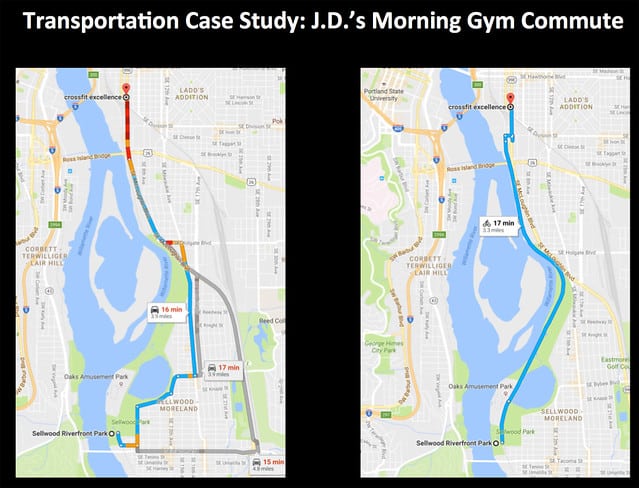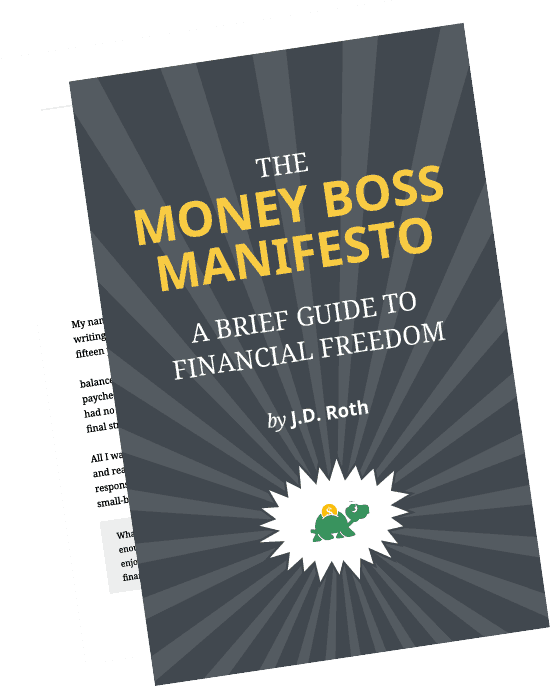Walkability score: The joys of a walkable neighborhood
Over the weekend, Kim and I began our hunt for a new home. We spent several hours combing local listings on Zillow and Redfin. We flagged the homes that looked interesting to us. Because I'm a total nerd, I compiled a spreadsheet of our absolute faves, listing important stats like price, home size, lot size, and — perhaps most important of all — walk score.

In the olden days, I picked my homes based on emotion. When my ex-wife and I bought our old farmhouse in 2004, that decision was rushed and irrational. I liked the idea of the place. I liked the large yard (two-thirds of an acre close in to Portland), the hundred-year-old house, and the cute hobbit-hole window in the living room. I didn't consider the massive amount of lawnmowing and yardwork. And I didn't pay attention to the fact that I'd have to drive almost anywhere I wanted to go.
A Driver's Life
When Kris and I moved into that drafty old house, we did a lot of driving. At the time, I was still working for the family box factory. Every morning, I spent half an hour driving twenty miles to work. Every evening, I did the reverse commute. We drove to buy groceries. We drove to visit friends. We drove to go out to dinner. I did go for walks through the neighborhood, but those were leisurely strolls without any particular purpose.
After I chose to become a money boss, I paid closer attention to my transportation costs. I looked for ways to drive less and walk more. At the time, I found that 90% of my driving was to the following locations:
- The gym, which was 8.5 miles (20 minutes) from home. It took 40 minutes to get there via a 2.5-mile pedestrian trail (which required illegally crossing a railroad bridge). I could bike the 8.5-mile route in 40 minutes.
- The nearest town, which was three miles (ten minutes of driving) from the house. It took 48 minutes to make the walk and 18 minutes to bike.
- The grocery store, which was one mile (five minutes driving) from home. Walking took me 15 minutes; biking took me six.
- Downtown Portland, which was ten miles (20 minutes) from home. Walking took three hours (I timed it once!), but biking took just 45 minutes.
Based on these times and distances, I changed my habits. I still drove to Portland most of the time, and I often drove to the nearby town. But since it took no longer than driving, I started biking to the grocery store. And when I had time — which was almost always — I walked to the gym instead of biking or driving. (Every time I crossed that railroad bridge, I thought of Stand By Me!)
A Walker's Life
After my divorce, I lived for a year in an apartment close to downtown Portland. The experience was a revelation. I'd always appreciated walking, but now it became clear that it was vital that I lived in a walkable neighborhood. I loved everything about being able to do my errands by foot (or by bike).
When I bought the condo where Kim and I currently live, I chose it because it was close to a vibrant neighborhood filled with restaurants and shops. There were parks nearby. Best of all, it sits directly on the multi-use path that allows Portlanders to bike and walk wherever they want to go.
Compared to the house where Kris and I lived, walking and biking are easy here.
- My gym is a 3.9-mile drive from home, which takes 12 minutes to drive without traffic. But when I go to the gym, I do so during rush hour, so it takes 17 minutes to drive. Via the multi-use path, it's only 3.4 miles to the gym, which takes an hour to walk or 17 minutes to bike. (That's right. During rush hour, it's just as quick to bike to the gym as it is to drive!)

- The nearest neighborhood is a 0.6-mile drive (four minutes) from home. It takes ten minutes to walk that distance and five to bike it.
- My current grocery store is a half-mile drive (four minutes) from home. It takes ten minutes to walk that distance and five to bike it.
- Downtown Portland is now five miles (12 minutes during non-peak traffic) from our house. It's 4.5 miles away via the multi-use path, which takes 25 minutes to bike and nearly 90 minutes to walk.
Last month, I rented office space about 1.5 miles from our condo. Naturally, I've spent the past few weeks clocking how long it takes me to cover that distance via different modes of transportation.
Most of the time, I walk to the office. That takes me exactly 30 minutes if I'm alone; it takes me 40-45 minutes when I'm accompanied by a certain hound dog. If I jog to work, I can cut that time in half; it takes only 15 minutes. It takes about 12 minutes to bike to the office now. Driving requires anywhere from eight to ten minutes, depending on traffic. (Last Thursday, though, it took 18 minutes to drive to work. Traffic was terrible.) Based on this data, it seems like biking and jogging are my best options.
When Walking Doesn't Work
Over the past decade, I've become a huge fan of walking, and I'm not afraid to trumpet its many benefits. It'll help you cut your transportation costs, sure, but it's also an investment in your health — both mental and physical. Walking is a great way to meet your neighbors and to get a better feel for the world around you.
But walking and biking aren't for everyone. I get that. Many cities aren't as bike- and pedestrian-friendly as Portland. If you live on a farm in the country, walking to the grocery store isn't an option. Plus, there are some places where it's too hot (or too cold) to make walking or biking practical.
In the middle of our cross-country RV trip, Kim and I paused for six months in Savannah, Georgia. I learned quickly that the South is actively hostile toward pedestrians and cyclists. There are few sidewalks and zero bike lanes. It's not just that there's no infrastructure for these activities, but nobody respects walkers and bikers. Kim and I probably had a dozen close calls each while walking around Savannah. (She once stopped a police officer to talk about the problem. He shrugged off her concerns. “Don't walk then. Cars will crush you.”)
Still, we made it work. Although there were no sidewalks, we found ways to skirt fences and cut through neighborhoods so that we could walk to get groceries. (What ought to have been a half-mile walk turned into almost two, but whatever.)
Looking Ahead
Now, as Kim and I seek to find a place that she and I can build a future together, I keep coming back to walkability. If we're going to live in town, I want a place where I can walk for most of my errands: groceries, mail, pubs, books, and so on. (There's a chance we'll choose to buy a place in the country; if that happens, I realize I'd sacrifice walkability. But I'd gain other advantages that would balance the loss.)
Yesterday, we looked at a nice place in a nearby suburb. It had everything we're looking for in a home — except that it was car-dependent. (Its walk score was 14, which is basically like living in the middle of nowhere.) We looked at another place that backed up on a large park — perfect for the hound dog! — but only had a walk score of 31. There's almost no way I can see myself putting up with the hassles of city living if I don't get one of the best benefits: the ability to walk and bike for errands (and for fun).
Exercise
Calculating transportation overhead is an ideal job for you as a money boss. Commit to spending a month (or three) tracking how you use your vehicle and what it costs. Keep a cheap spiral notebook and a pen in your car (or take notes on your cell phone). Whenever you make a trip, log the time and the distance. Write down how much you spend on fuel and maintenance.Meanwhile, also take the time to measure how long it takes you to bike or walk or take the bus to common nearby destinations. When you've finished the experiment, look at the numbers. Can you spot any patterns? When does it make sense to drive? When does it make sense to walk or take the bus? Here's a final question: If you were to sell your car (or cars), how much would you get?
Become A Money Boss And Join 15,000 Others
Subscribe to the GRS Insider (FREE) and we’ll give you a copy of the Money Boss Manifesto (also FREE)
